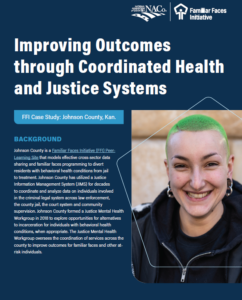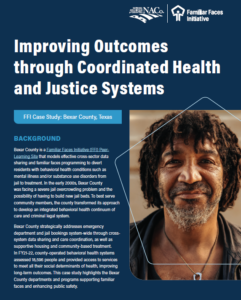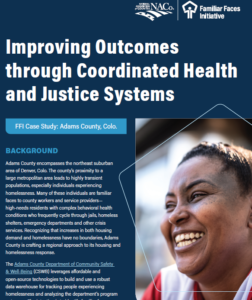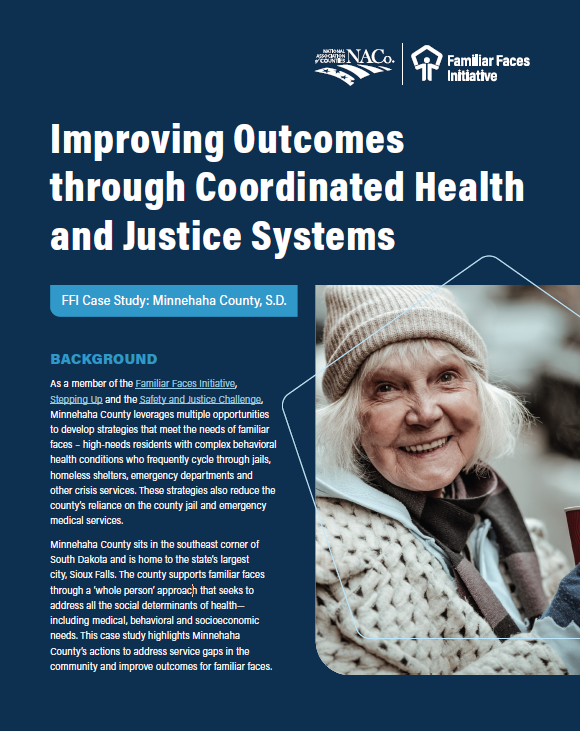Case Study: Orange County, Calif.
 Orange County is a Familiar Faces Initiative (FFI) Peer-Learning Site modeling effective cross-sector data sharing and familiar faces programming for the FFI community. In 2017, Orange County faced growing number of high-needs residents with complex behavioral health conditions who were frequently cycling through the county’s jails, homeless shelters, emergency departments and other crisis services. In FY2021-2022, data from the Orange County Sheriff’s Department and Health Care Agency showed that approximately 1,256 individuals were booked into custody four or more times, and the associated costs for the resources available to those individuals represented about 15-200 percent of the County’s total budget.
Orange County is a Familiar Faces Initiative (FFI) Peer-Learning Site modeling effective cross-sector data sharing and familiar faces programming for the FFI community. In 2017, Orange County faced growing number of high-needs residents with complex behavioral health conditions who were frequently cycling through the county’s jails, homeless shelters, emergency departments and other crisis services. In FY2021-2022, data from the Orange County Sheriff’s Department and Health Care Agency showed that approximately 1,256 individuals were booked into custody four or more times, and the associated costs for the resources available to those individuals represented about 15-200 percent of the County’s total budget.
Seeking a better model that would both reduce costs and improve outcomes for this small number of people, Orange County Supervisor Andrew Do developed a vision for county service providers to share data and develop individualized case plans to meet the specific needs of each high-needs person. This case study highlights Orange County’s implementation of a data-sharing technology platform and care coordination program to improve outcomes for familiar faces.
Case Study: Johnson County, Kan.
 Johnson County is a Familiar Faces Initiative (FFI) Peer-Learning Site that models effective cross-sector data sharing and familiar faces programming to divert residents with behavioral health conditions from jail to treatment. Johnson County has utilized a Justice Information Management System (JIMS) for decades to coordinate and analyze data on individuals involved in the criminal legal system across law enforcement, the county jail, the court system and community supervision. Johnson County formed a Justice Mental Health Workgroup in 2008 to explore opportunities for alternatives to incarceration for individuals with behavioral health conditions, when appropriate. The Justice Mental Health Workgroup oversees the coordination of services across the county to improve outcomes for familiar faces and other at-risk individuals.
Johnson County is a Familiar Faces Initiative (FFI) Peer-Learning Site that models effective cross-sector data sharing and familiar faces programming to divert residents with behavioral health conditions from jail to treatment. Johnson County has utilized a Justice Information Management System (JIMS) for decades to coordinate and analyze data on individuals involved in the criminal legal system across law enforcement, the county jail, the court system and community supervision. Johnson County formed a Justice Mental Health Workgroup in 2008 to explore opportunities for alternatives to incarceration for individuals with behavioral health conditions, when appropriate. The Justice Mental Health Workgroup oversees the coordination of services across the county to improve outcomes for familiar faces and other at-risk individuals.
Case Study: Adams County, Colo.
Adams County encompasses the northeast suburban area of Denver, Colo. The county’s proximity to a large metropolitan area leads to highly transient populations, especially individuals experiencing homelessness. Many of these individuals are familiar faces to county workers and service providers—high-needs residents with complex behavioral health conditions who frequently cycle through jails, homeless shelters, emergency departments and other crisis services. Recognizing that increases in both housing demand and homelessness have no boundaries, Adams County is crafting a regional approach to its housing and homelessness response.
The Adams County Department of Community Safety & Well-Being (CSWB) leverages affordable and open-source technologies to build and use a robust data warehouse for tracking people experiencing homelessness and analyzing the department’s program outcomes. The intention is to identify familiar faces within Adams County and neighboring counties and assess whether existing programs are effectively meeting the needs of vulnerable residents.
Case Study: Bexar County, Texas
 Bexar County is a Familiar Faces Initiative (FFI) Peer-Learning Site that models effective cross-sector data sharing and familiar faces programming to divert residents with behavioral health conditions such as mental illness and/or substance use disorders from jail to treatment. In the early 2000s, Bexar County was facing a severe jail overcrowding problem and the possibility of having to build new jail beds. To best serve community members, the county transformed its approach to develop an integrated behavioral health continuum of care and criminal legal system.
Bexar County is a Familiar Faces Initiative (FFI) Peer-Learning Site that models effective cross-sector data sharing and familiar faces programming to divert residents with behavioral health conditions such as mental illness and/or substance use disorders from jail to treatment. In the early 2000s, Bexar County was facing a severe jail overcrowding problem and the possibility of having to build new jail beds. To best serve community members, the county transformed its approach to develop an integrated behavioral health continuum of care and criminal legal system.
Bexar County strategically addresses emergency department and jail bookings system-wide through cross-system data sharing and care coordination, as well as supportive housing and community-based treatment. In FY21-22, county-operated behavioral health systems assessed 18,596 people and provided access to services to meet all their social determinants of health, improving long-term outcomes. This case study highlights the Bexar County departments and programs supporting familiar faces and enhancing public safety.
Case Study: Minnehaha County, S.D.
As a member of the Familiar Faces Initiative, Stepping Up and the Safety and Justice Challenge, Minnehaha County leverages multiple opportunities to develop strategies that meet the needs of familiar faces – high-needs residents with complex behavioral health conditions who frequently cycle through jails, homeless shelters, emergency departments and other crisis services. These strategies also reduce the county’s reliance on the county jail and emergency medical services.
Minnehaha County sits in the southeast corner of South Dakota and is home to the state’s largest city, Sioux Falls. The county supports familiar faces through a ‘whole person’ approach that seeks to address all the social determinants of health—including medical, behavioral and socioeconomic needs. This case study highlights Minnehaha County’s actions to address service gaps in the community and improve outcomes for familiar faces.
Case Study: Denver City and County, Colo.
In 2016, the City and County of Denver (Denver) launched a novel approach to 911 emergency response. By embedding licensed clinicians with police officers, their co-responder program seeks to improve 911 response for individuals experiencing behavioral health crises. Since its inception, the co-responder program has grown from four clinicians to 32 (soon to be 42 with an overnight shift) and connected countless people with behavioral health treatment and services as an alternative to arrest. In November 2018, voters overwhelmingly passed the Caring for Denver ballot initiative which created a 0.25 percent sales tax increase or mental health and substance abuse services. This tax has generated roughly $35 million annually with at least 10 percent of those funds allocated to specific public safety services and training related to mental health and substance abuse. Leveraging this momentum, in June 2019, a team of individuals from the city and local non-profit organizations participated in a three-day experiential learning session with Crisis Assistance Helping Out on the Streets (CAHOOTS) in Eugene, Ore. With the Denver Police Department reporting mental health-related calls up 17 percent over the previous three-year average heading into 2020, the time was ripe to expand the work of the co-responder program and develop a Case Manager Hub in the Denver Police Department.
Case Study: Dane County, Wis.

In 2016, Dane County joined Data Driven Justice (DDJ), committing to data sharing and integration across justice, health, and community services systems in an effort to divert individuals with substance use disorders and mental illnesses away from the justice system and decrease or eliminate their need for emergency services. The county also resolved to better understand and address the racial disparities within these systems. Dane County has devoted significant time and resources to integrate and use that data to identify gaps in care and other problems within the crisis response system. Long standing efforts on criminal justice reform in Dane County, in addition to growing community support, led the County Board to approve an expansive reform package in October of 2020.2 This package included a triage and restoration center, a community justice center, and protocol changes for a crisis first responder pilot program. This case study shares Dane County’s recent successes providing crisis response services to residents in need and the steps that led to these successes.
Case Study: McLean County, Ill.
In 2013, McLean County requested assistance from the National Institute of Corrections (NIC) to study the availability and quality of mental health services within its jail system and the community. NIC reported a direct correlation between the lack of available community-based resources and the number of people with mental illness and/or substance use disorders arrested. Based on NIC’s assessment and recommendations, the McLean County Board developed the “McLean County Mental Health Action Plan,” which identifies immediate and long-term steps for the Board, county departments and service providers. The plan’s primary goal is to understand and improve the intersection of the justice and behavioral health systems in the county, ultimately by identifying and assigning responsibilities by agency.
COLLABORATING TO RESPOND TO PEOPLE IN CRISIS
Through the county’s participation in the Data-Driven Justice (DDJ) project and other national initiatives, McLean County leaders have continued to build on their Mental Health Action Plan with concerted efforts to collaborate and implement initiatives aimed at reducing individuals’ with mental illness involvement with the criminal justice system and usage of emergency departments and homelessness services. Together, county justice, health and behavioral health stakeholders have:
- Continued its mobile crisis team and hotline
- Enhanced training for law enforcement officers and other first responders
- Developed specialty courts
- Identified gaps in services through cross-systems collaboration and data analyses
- Operationalized plans to provide specialized jail units for people with mental illness and special needs
- Opened a triage center that serves as a walk-in facility and diversion option and provides crisis intervention and linkages to follow-up services 365 days per year
- Implemented a Frequent Users System Engagement (FUSE) Program to provide intensive wrap-around case management to individuals who have intersected multiple systems most frequently
- Arranged for the same psychiatric prescriber assigned to the FUSE Program to also be assigned as the psychiatric prescriber for participants while detained, allowing for an improved continuum of care for those who may transition from one to the other
- Partnered with the NYU Criminal Justice Lab to pilot a screening tool for law enforcement officers to use in the field to identify people with mental illness or substance use disorders or who are experiencing homelessness, and
- Utilized a Bureau of Justice Assistance grant through the Justice and Mental Health Collaboration Program to establish a Comprehensive Assessment Team to implement a systematic approach for assisting justice-involved youth.
In developing these programs, county leaders realized the need to use data to better identify and serve frequent utilizers of health, human services and justice systems.
IDENTIFYING AND SERVING FREQUENT UTILIZERS
Recognizing the need to address information-sharing gaps and inefficiencies, McLean County created an integrated justice information system (IJIS) in 1997 that has expanded over the years to include data from law enforcement officers throughout the county, the jail, court, prosecutor, public defender, probation and parole. The IJIS assigns a unique identifier to each individual entering the criminal justice system, which helps track the number of times that person is involved in the justice system, their case processing time and the type and severity of charges.
Nearly two decades later, as a part of its efforts to address behavioral health treatment needs of community members, McLean County partnered with the Corporation for Supportive Housing (CSH) and adopted its Frequent Users System Engagement (FUSE) model. FUSE identifies frequent users of jails, shelters, hospitals and/or other public crisis services and provides stabilization and wrap-around services through supportive housing.
As part of this effort, the county and CSH partnered with the Center for Data Science and Public Policy (DSaPP) at the University of Chicago to create a data-matching tool that combines data sets from local housing and homelessness systems with IJIS data to identify individuals who regularly cycle between these systems and provide them with targeted assistance. McLean County was one of four pilot programs to implement this data-matching tool, which has allowed it to assess and integrate 20 years of justice data and five years of homelessness data.
The data-matching tool integrates all IJIS and Homeless Management Information System (HMIS) information once per month. This monthly update allows the county’s behavioral health administrator to complete a report that highlights the intersections between the two data sets over the past 18 months and sort results based on total number of contacts across all systems and most recent HMIS contacts. Using the tool’s report and DSaPP analytics, the county is able to identify the top 20 frequent utilizers, often with eight or more contacts between the two systems within an 18-month period.
Once individuals are identified for the program through this report, FUSE staff begin the outreach process, which may take place wherever the person is located (e.g., jail, shelter visits, court or other service point of contact). Individuals meet with FUSE staff to discuss the program and sign consent forms. Clients then meet with staff regularly – often daily – to support access to housing, behavioral health treatment and other resources they may need to be successful.
As the county measures long-term behavioral and physical health outcomes of FUSE participants and evaluates the impact of the model, it hopes to expand its data-sharing partnerships to behavioral health providers and local hospitals. This expansion would provide greater access to more comprehensive data that the county can use to better understand an individual’s diagnostic and location information and history of service use. Access to this additional data will help improve the county’s ability to identify and better serve its frequent utilizers.
This case study was created with support from Arnold Ventures as part of Data-Driven Justice, a project that aims to support local jurisdictions in using data to better align resources to respond to people who are frequent utilizers of justice, health and human services systems.
DOWNLOAD
Case Study: Philadelphia, Pa.
Philadelphia formed its Criminal Justice Advisory Board (CJAB) in 2008 as a collaborative council composed of local criminal justice and social services stakeholders. By conducting periodic system assessments and developing performance indicators to determine progress in meeting collective goals, CJAB members use their program and policy expertise to take a systematic approach to addressing a broad range of criminal justice issues.
Among the CJAB’s successes, recent collaborative efforts among criminal justice, health and community partners have led to better use of data and the implementation of innovative practices to reduce Philadelphia’s jail population. In just a few short years, Philadelphia successfully reduced its jail population by roughly 41 percent (from 8,082 in July 2015 to approximately 4,700 as of February 2020).
Collaboration and coordinated efforts among CJAB members have not only helped drive down Philadelphia’s jail population, but also helped shift the culture within local agencies around data collection and usage. This case study highlights some of the initiatives and practices that Philadelphia has implemented to better coordinate, evaluate and share its criminal justice data to serve vulnerable residents.
Developing Robust Data Systems
Through its participation in Data-Driven Justice (DDJ) and other national initiatives, Philadelphia has implemented key information sharing projects and platforms to effectively address the needs of frequent utilizers of health, human services and justice systems and improve outcomes across agencies.
In 2016, the CJAB began the development of a robust information sharing framework with the execution of a memorandum of understanding (MOU) outlining clear parameters around the exchange and external reporting of data between local agencies and an overall shift in priorities across agencies to one of analysis, collaboration and a focus on outcomes over process. The framework was an integral start to improving coordination among disparate system actors and developing tools to facilitate the sharing and integration of information and data.
In addition, Philadelphia has put significant emphasis on building and expanding data capacity through the formation of an interagency data team led by the First Judicial District. In 2018, this data team started producing monthly reports on the jail population and a public-facing dashboard with performance measures. These tools are designed to give practitioners and policymakers a clear understanding of Philadelphia’s jail population at any given time. The dashboard also provides disaggregated data that highlights critical information about racial and ethnic disparities, length of stay and serious mental illness (SMI) status.
Efforts to standardize language, improve data usability and create systems that make shared information accessible and usable to multiple audiences have allowed Philadelphia’s leaders to become better-informed decision makers and helped drive a steady reduction in the jail population.
Creating Processes to Understand Systems Users
Philadelphia’s Department of Behavioral Health and Intellectual disAbility Services (DBHIDS) has implemented innovative data management strategies to address a large volume of individual level information that exists across a wide network of partners.
A frequent challenge with sharing data and information is having multiple records for the same person without a unique identifier. DBHIDS developed an automated process to better assess whether information from two distinct data sources references a single unique individual, allowing practitioners to automatically link the information together to create that individual’s “golden record.” This record provides a clear understanding of a person’s touch points across different behavioral health and emergency systems and gives experts the ability to match data from different sources to an individual when predefined criteria are met. This approach increases the reliability of information related to transactions and provides practitioners and decision makers with datasets that can be easily integrated and synthesized. The end result is a data management system that emphasizes data reusability, not just data sharing. In practice, this system allows DBHIDS to evaluate an individuals’ history of system interaction to assess patterns, identify frequent utilizers and make decisions about the most appropriate services or interventions.
In conjunction with these efforts, DBHIDS established an internal system to analyze and evaluate justice initiatives through a process called Forensic 360. The process gives data analysts a “360 degree” view of a person’s involvement with justice and health systems, allowing for a deeper exploration of an individuals’ experience with incarceration, treatment and more. Forensic 360 provides analysts the ability to survey thousands of individual records in a repeatable and reliable manner, identify baseline data and develop comparison cohorts for better evaluation and measurement. With this process, analysts are able to more efficiently and accurately understand the impact of services and programs. An added component of Forensic 360 is that it gives the ability to customize data for specific audiences and limit access based on the end users’ specific needs. This feature to refine and limit access to available datasets helps DBHIDS and partner agencies mitigate privacy concerns. Data requests that fall outside of original scopes of work require new executive and legal approval, making Forensic 360 a powerful tool to help facilitate improved coordination and streamlining of future data-sharing agreements and ensure legal compliance.
DBHIDS plays an important role in advancing and sustaining the health and wellbeing of Philadelphia residents. The creation and use of data-integration systems provide a foundation for DBHIDS to reflect on service delivery and continuously make improvements in service quality. This sound approach to data governance, which involves decision makers, subject matter experts and IT professionals alike, is driven by a culture of collaboration and shared vision that guides organizational goals and outcomes.
This case study was created with support from Arnold Ventures as part of Data-Driven Justice, a project that aims to support local
jurisdictions in using data to better align resources to respond to people who are frequent utilizers of justice, health and human services
systems.
DOWNLOAD
Case Study: Bernalillo County, N.M.
In September 2017, the Substance Abuse and Mental Health Services Administration (SAMHSA), the National Association of Counties (NACo) and the Laura and John Arnold Foundation (LJAF) hosted the Data-Driven Justice and Behavioral Health Design Institute (Design Institute) in Rockville, Md. The Design Institute convened 13 teams committed to the Data-Driven Justice (DDJ) initiative. Teams were selected through a competitive process to work directly with expert faculty in facilitated sessions and workshops to create action plans for developing and using integrated data systems that would aid their jurisdictions in identifying high utilizers of jails and crisis services. This case study is part of a series highlighting counties that participated in the Design Institute.
GETTING STARTED
Developing resources to treat the behavioral health conditions of high utilizers—also called frequent utilizers—is one of the major strategies Bernalillo County is using to reform its justice system and improve health outcomes. Through the Albuquerque/Bernalillo County Government Commission (ABCGC), the county and city collaborate to design and implement community-based programs that help the high utilizer population access the treatment and programs they need to live well, including supportive housing for people leaving the jail and mobile crisis teams that deescalate situations stemming from 911 calls that involve people in a behavioral health emergency.
The Bernalillo County Criminal Justice Coordinating Council (BCCJCC), which includes representation from the Bernalillo County Board of Commissioners, law enforcement and major stakeholders in the criminal justice system, has been essential in developing and implementing new programs and resources for frequent utilizers of the justice system. To begin identifying this population, Bernalillo County uses data from the jail—also referred to as the Metropolitan Detention Center (MDC)—and its Psychiatric Acute Care (PAC) housing unit, which has 100 beds and provides both mental health and substance abuse treatment. Bernalillo County defines high utilizers as
individuals who have had five or more interactions with PAC within three years. The county has conducted several studies to determine the needs and impact of frequent utilizers on systems and to examine their outcomes. There is a countywide understanding, from residents to elected officials, that individuals with complex physical health, behavioral health, criminal justice and social service needs consume disproportionate amounts of local services and resources.
Bernalillo County and the City of Albuquerque share data and collaborate with local hospitals, behavioral health service providers, criminal justice partners and other community organizations to connect people to programs and services upon their release from MDC. Through a partnership with University of New Mexico (UNM) and its Institute for Social Research (ISR), researchers have matched jail data with information from the Bernalillo County Department of Addiction Treatment Services (DATS), the sheriff’s Crisis
Intervention Unit, which responds to calls involving mental health crises, and Albuquerque Health Care for the Homeless, which is a federally qualified health center providing services to homeless people. The courts recently agreed to share their data with the county in order to better understand how cases move across the justice system and the impact of the court system on the Bernalillo County corrections system. While Bernalillo County has access to a variety of data sources, data collection is often done manually. There is no integrated data system or warehouse, making the data-matching process labor intensive and time consuming.
Through its involvement in the Data-Driven Justice (DDJ) initiative, Bernalillo County has deepened its commitment to using data to steer and inform its policy and programming decisions. Under the direction of the BCCJCC and the county’s dedicated DDJ team, which attended the Design Institute, the county has prioritized building upon its existing data-driven efforts to improve service delivery and health outcomes for individuals with complex health and social needs. Ultimately, it wants to have a county-wide data integration strategy that includes the operational definition of frequent utilizers and uses a software program for aggregating and analyzing data.
MAKING PROGRESS BY LEVERAGING RESOURCES AND RELATIONSHIPS
In 2015, Bernalillo County enacted a new tax to support the expansion of behavioral health services within the county. The tax supports the Behavioral Health Initiative (BHI), which is a business plan for a comprehensive system of behavioral health services, with an emphasis on coordinated crisis, stabilization and long-term services. The plan includes an administrative structure with formal oversight of service coordination and funding allocations. To guide the development of the business plan, the county enlisted the assistance of outside consultants to help it identify priorities, gaps and needs and to design new service delivery models.
Four subcommittees recommend how funding should support behavioral health services in four domains, including 1) crisis services, 2) community supports, 3) supportive housing and 4) prevention, intervention and harm reduction. Each subcommittee has a formal goal and is assigned projects that are identified in the business plan. For example, the community supports subcommittee is responsible for improving services in the community that will stabilize individuals and prevent crisis. It works on projects that include crisis respite, forensic assertive community treatment and peer-supported and drop-in services. Each subcommittee has a chair and co-chair and these leaders also sit on the BHI steering committee. The steering committee is overseen by the ABCGC.
BHI is funding the expansion of an existing supportive housing program. The program connects people leaving jail with a place to live and services to support their health and well-being. To be eligible, participants must meet criteria related to income, homelessness and behavioral health needs and they must be able to live independently. Priority is given to people who are frequently booked into MDC and have more severe behavioral health conditions. Eligible individuals are then referred to one of three service providers for an assessment. After intake and assessment—processes that begin in the jail—the service provider will develop a transition plan. Housing begins immediately upon release from jail. The county leverages the Housing Choice Voucher Program supported by the U.S. Department of Housing and Urban Development to directly pay landlords.
Mobile Crisis Teams (MCTs) have also been implemented through the BHI. MCTs embed social workers and counselors with at least a master’s degree in the Bernalillo County Sheriff’s Office and Albuquerque Police Department. These behavioral health professionals are employed by St. Martin’s Hospitality Center, a non-profit that operates shelter and housing programs and offers employment and mental health services. The teams are dispatched through 911 calls involving people experiencing a behavioral health emergency with the goal of reducing unnecessary jail bookings and emergency room transports by stabilizing people in the field. MCT is different from crisis intervention training used by law enforcement officers, which aims to educate officers on the signs of mental illness, train them to deescalate crisis situations and exercise their discretion to divert or refer to additional resources. MCT leverages the training and certifications of social workers and counselors to recommend treatment options and, because of their affiliation with St. Martin’s Hospitality Center, they can
broker access to community-based programs.
MOVING FORWARD AND ADVANCING NEW IDEAS
Because of its relationship with UNM, Bernalillo County is able to advance a commitment to evidence-based decision-making. The Institute for Social Research (ISR) provides assistance in support of numerous county initiatives, including identifying the evidence on which to develop programs and evaluating the impact of jail population reduction initiatives, the BHI and the county’s substance abuse programs.
The university also plays a direct role in implementation. Bernalillo County is getting ready to launch Project ECHO with the University of New Mexico Hospital (UNMH) to improve how people leaving the jail are linked to services. The first part of the project involves training jail and reentry staff on motivational interviewing and client-driven, strengths-based counseling approaches. UNMH will then do biweekly meetings with staff after the initial training to ensure processes are implemented with fidelity to design. Quarterly meetings will be held
to focus on gaps in community-based service systems and how to address them.
Project ECHO is also being used to support the success of the Resource Re-entry Center (RRC), which the county opened in May 2018. Bernalillo County MDC discharges 70 to 80 people a day and between one-quarter and one-third of those people were involved with PAC while in jail, including a handful of individuals who are classified as frequent utilizers. In conjunction with transition planning that begins while someone is in jail, the resource center’s purpose is to connect people with a wide spectrum of services that will support their health and wellbeing
in the community. Transition planners and service navigators affiliated with UNMH staff the RRC and MDC provides transportation from the jail to the resource center, which is open 24/7. The county expects that close to 21,000 people will access the RRC each year.
Bernalillo County is also expanding access to medication-assisted treatment (MAT) for people in jail. More than 360 people detox from opioids while in MDC each month. Research shows that people are more likely to die of an opioid overdose in the first week of discharge from a correctional facility than other times following release. Studies also show that increasing the availability of MAT—which combines pharmaceuticals with counseling to address the physiological and psychological dimensions of addiction—can significantly decrease overdoses. For more than 10 years, the county has provided MAT to people in MDC who were already receiving methadone
treatment prior to entering jail. The jail’s contracted health provider verifies the prescription and dosing regimen with the community-based prescriber. Bernalillo County recently began offering people in the jail the option to start MAT and then continue treatment in the community with a self-selected provider when released. The program currently operates at no cost to the county through a grant from the state.
County leaders are leveraging their experience with using data and evidence-based strategies to strengthen the continuum of care for people who are involved in the justice system. As the county continues its work to create comprehensive service delivery models, it looks for ways to enhance its use of data and analytics to inform its decisions and evaluate the impact of its investments. Through its participation in the Design Institute, Bernalillo County identified new ways to approach its data integration goals and continue its mission to efficiently address the needs of frequent utilizers.
NACo would like to thank Bernalillo County Commissioner Maggie Hart Stebbins and Technical Advisor to the County on Adult Detention Reform Elizabeth Simpson for sharing information on the county’s efforts.
DOWNLOAD
Case Study: Dallas County, Texas

In September 2017, the Substance Abuse and Mental Health Services Administration (SAMHSA), the National Association of Counties (NACo) and the Laura and John Arnold Foundation (LJAF) hosted the Data-Driven Justice and Behavioral Health Design Institute (Design Institute) in Rockville, Md. The Design Institute convened 13 teams committed to the Data-Driven Justice (DDJ) initiative. Teams were selected through a competitive process to work directly with expert faculty in facilitated sessions and workshops to create action plans for developing and using integrated data systems that would aid their jurisdictions in identifying high utilizers of jails and crisis services. This case study is part of a series highlighting counties that participated in the Design Institute.
Through its involvement in the Data-Driven Justice (DDJ) initiative, Dallas County has committed to a using a data-driven approach to expand the care continuum for justice-involved individuals with complex behavioral health needs who are high utilizers of services. At the Design Institute, the county prioritized increasing the means and degree of collaboration between behavioral health stakeholders, which included focusing on how data integration improves identification, assessment and warm hand-offs of the justice-involved population to community-based treatment and supports.
Download.
Case Study: Prince George’s County, Md.

In September 2017, the Substance Abuse and Mental Health Services Administration (SAMHSA), the National Association of Counties (NACo) and the Laura and John Arnold Foundation (LJAF) hosted the Data-Driven Justice and Behavioral Health Design Institute (Design Institute) in Rockville, Md. The Design Institute convened 13 teams committed to the Data-Driven Justice (DDJ) initiative. Teams were selected through a competitive process to work directly with expert faculty in facilitated sessions and workshops to create action plans for developing and using integrated data systems that would aid their jurisdictions in identifying high utilizers of jails and crisis services. This case study is part of a series highlighting counties that participated in the Design Institute.
At the Design Institute, Prince George’s County identified several needs to improve how it identifies high utilizers and coordinates their connection to treatment and support services, including determining what information should be collected electronically and what data should be integrated, as well as implementing a data platform that would allow for real-time data sharing. Ultimately, the county wants to create synergy between a wide range of county government agencies and partners, forge alliances between data owners and develop a system-wide approach to diversion.





